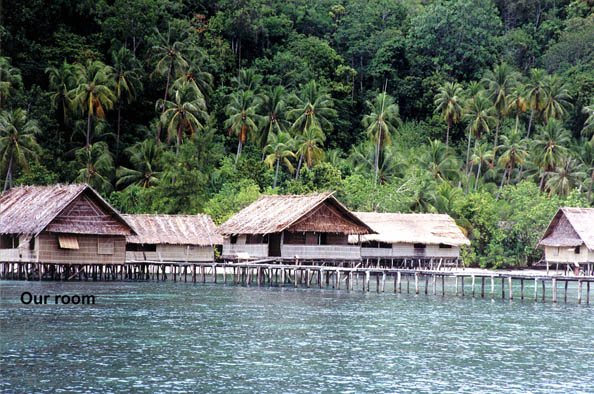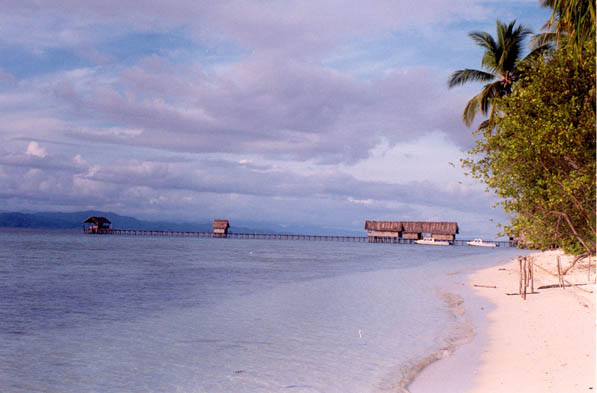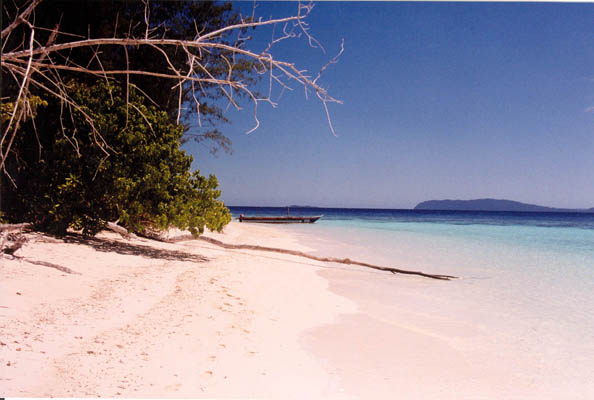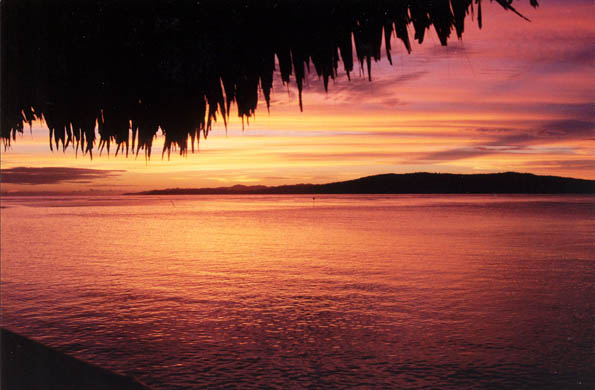Diving in Paradise: An Expedition to Papua
(Note that you can click on small images to see the full-size version)
 It's not every day that you can see a shark from your hotel window. But the Kri Island Resort is not your everyday hotel, and Kri Island is hardly your usual tourist refuge. The island, a fringe of coco palm-shaded beach surrounding a steep and jungled mountain spine, lies two hours by boat north of Sorong, on the far northwestern edge of Papua, the Indonesian half of New Guinea.
It's not every day that you can see a shark from your hotel window. But the Kri Island Resort is not your everyday hotel, and Kri Island is hardly your usual tourist refuge. The island, a fringe of coco palm-shaded beach surrounding a steep and jungled mountain spine, lies two hours by boat north of Sorong, on the far northwestern edge of Papua, the Indonesian half of New Guinea.
What drew us to Kri was the diving. The waters -- at the crossroads of the Indian and Pacific Oceans -- are reputed to be the richest marine environment in the world. The diving was as good as promised but the surprise was that this turned out to be far more than a diving holiday. What made the trip so rewarding was the unspoiled natural beauty above the tide line, combined with a tranquility rarely found in the world's fourth most populous country. The resort, run by an idiosyncratic Dutchman, only heightened the sense of quiet enjoyment.
We arrived at Sorong's Jefman airport on Saturday, ending a journey that had started at 2:30 am when we woke up to catch a flight that departed at the ungodly hour of 5 in the morning. Jefman is an air strip on a small island of the same name and dates from the Second World War, when New Guinea was a key battleground between American and Japanese forces. The runway, which lies beside a small village, takes up much of the available land. Once the plane taxis to the rudimentary terminal (an irregular occurrence), village kids once use the runway as a bicycle path.
The guidebooks say Sorong has little to recommend it and they're right. It's a grotty place with a grotty but busy harbor, as it's the center for the timber trade and a base for oil and gas exploration in northwest Papua. An influx of refugees fleeing communal violence in Sulawesi and the Maluku islands to the west has almost doubled the population in the last few years, locals say. Sorong looks like a typical but rundown Indonesian city and native Papuans are a distinct minority. We stayed at the Grand Pacific Hotel, which was fine, but smelled musty and was none too grand.

The next morning it was off to Kri Island, north across the Dampier Straits, and the resort built and managed by Max Ammer, a former Dutch commando and Harley Davidson mechanic who runs Irian Diving. Ammer came to the Raja Ampat Islands in 1989, looking for Second World War wrecks, and the salvage he could take off them. He bought a Zodiac, filled it with gasoline, dive gear and a compressor and headed off on his own. For a while, he supported himself salvaging Coke bottles dating from the war. When he came across what seemed like a promising reef, down he'd go. It's not the safest way to dive but over the years, he built up a vast knowledge of local dive spots and found numerous ship and aircraft wrecks.
The resort is the sole habitation on Kri. It is small, with accommodations for 14 guests, and spartan, but wonderfully so. Ammer calls it "low-impact tourism," which is exactly right. There's no air-conditioning, no television, no radio. There's email, of course, but it comes by boat. Email sent to Irian Diving's Sorong office is printed and delivered whenever a supply boat comes in. A generator set back from the resort runs all night but provides only enough power to run battery chargers and provide limited lighting.
All the buildings have thatched roofs, with walls made from bamboo or strips of sago palm. Doors are woven mats that slide on runners made from stout tree branches. Papuan ingenuity can be startling. In one case, a door hinge consisted of a pole rotating inside pieces of bamboo lashed to the building frame with vines. Bed are mosquito-netted mattress on the floor and, as the five sleeping units are built on a jetty over the water, night noises are the sounds of the sea lapping against the pilings. Chairs and benches are built from bamboo and strips of palm wood by the father of one of the staff. The bathrooms, with western toilets, and the showers, with a barrel of water and a small bucket, have walls for privacy but are open at the eaves. You take your morning shower listening to the calls of the parrots, hornbills and other birds.
The meals are as spartan and as pleasing as the resort. No fine cuisine, just fresh fish and rice and fruit and vegetables, including local dishes like mountain fern or other Papuan ![]() greens that don't really have names. Meals are taken at a long communal table and the dining hall is the social center of the resort. It's a place where people gather for a tea or cold drink, chat about their day or use one of the books from the small resort library to identify a fish or marine critter or a bird they've seen.
greens that don't really have names. Meals are taken at a long communal table and the dining hall is the social center of the resort. It's a place where people gather for a tea or cold drink, chat about their day or use one of the books from the small resort library to identify a fish or marine critter or a bird they've seen.
The Raja Ampat (Four Kings) archipeligo covers about 40,000 sq. km and lies just south of the equator. But it is home to a population of less than 50,000 people, with about 5,000 living in the immediate area of Kri Island. Living as we do in Jakarta, we think of Indonesia as a densely populated land but this was a side of the country we had not experienced. Most days, the only people we saw were an occasional fisherman in an outrigger canoe. Often, there was no one else. It felt like parts of northern Ontario.
Marine biologists working for Conservation International consider that the waters of the Raja Ampat Islands harbor perhaps the richest biodiversity of marine life in the world. "The area supports some of the richest coral reefs in the entire Indonesian Archipelago," their report says. "The coral and fish faunas are particularly rich with perhaps the greatest number of species of any place in the world." More than half of all identified hard coral species in the world have been found in the Raja Ampats. Dr. Gerald Allen, an expert on reef fish who led the expedition, broke his record for species recorded -- twice. During his three-week stay, he identified 950 different species.
The variety is such that, underwater, you sometimes don't know where to look. Should you pay attention to the pygmy seahorses the size of a water droplet that live on the
![]() gorgonian sea fans, and mimic the color of the fans so well that they are almost impossible to see? There are endless kinds of nudibranchs, small sea slugs that come in a dazzling array of colors and patterns. Clouds of reef fish in every color can be so dense, they block your vision.
gorgonian sea fans, and mimic the color of the fans so well that they are almost impossible to see? There are endless kinds of nudibranchs, small sea slugs that come in a dazzling array of colors and patterns. Clouds of reef fish in every color can be so dense, they block your vision.
On one dive, one a reef off a small limestone cay called Mios Kon, we found thousands of yellow seaperch, 30 or 40 centimeters in length, lining up in huge schools that covered the reef. At the same time, a black-spotted goatfish was digging in sand up past its eyes, searching for a meal of shrimp. On another outing at Sardine Reef, hundreds of Moorish Idols, with their long showy dorsal fin, competed for attention with endless schools of fusiliers.
There were baby reef sharks in the shallows in front of the resort, where the waters are great for snorkeling. Laurenne found a large red octopus during one dive. But while the  baby sharks live near the resort, their parents are out in the deeper waters. We saw white-tip and black-tips on nearly every dive, including a big white tip, maybe 2 metres in length, patrolling the base of the reef at the eastern end of the island, moving effortlessly in a current that we were unable to swim against. In addition to the reef sharks, there are also wobbegong sharks, a weird animal, flattened almost like a ray, but with a shark's dorsal fin and tail. Some species have flaps of skin growing off their mouths and around their head that look like tassles. Usually, they were found in small coral caves or on the seabed, looking for all the world like a messy brown carpet.
baby sharks live near the resort, their parents are out in the deeper waters. We saw white-tip and black-tips on nearly every dive, including a big white tip, maybe 2 metres in length, patrolling the base of the reef at the eastern end of the island, moving effortlessly in a current that we were unable to swim against. In addition to the reef sharks, there are also wobbegong sharks, a weird animal, flattened almost like a ray, but with a shark's dorsal fin and tail. Some species have flaps of skin growing off their mouths and around their head that look like tassles. Usually, they were found in small coral caves or on the seabed, looking for all the world like a messy brown carpet.
Off in the blue at the base of the reef, where the sharks were, we could often see large schools of really big barracudas, circling the reef or just hanging in the current. On one occasion, again on Sardine Reef, they came right up to us. Barracudas on the right of us. Barracudas on the left of us. There were also shark-size dog-tooth tuna, Spanish mackeral, and Queensland Gropers, massive creatures almost 3 metres in length, so big they look like Volkswagen Beetles swimming through the water. We also dived the wreck of a B-47. Three went down the same day in 1944 near Wei Island, with no loss of life. The wreck we visited was in 100 feet of water, upside down and pointing up the reef. It was so heavily overgrown with coral that, as we descended, it took a while for the eye to make out its original contours. A big scorpionfish was hanging out on a twisted piece of propeller and a blue-striped sea perch had made its home in the engine cowling. Peering into the cockpit, I could make out the instruments but they were all but covered with sea life. A large hard coral had taken root on one wing and nearby, a Regal Angelfish watched over a large table coral.

After the dive, the boat maneuvered through the Wei Island lagoon and anchored near the beach. Out came the hampers of food, chicken and rice and veg. Cream-colored sand beaches were shaded by coconut palms and the sea was a clear turquoise shading to a rich deep blue. It was quiet and still. It was paradise and it was hard to get back into the boat at the end of the interlude.
Max and many of his staff of 25 are Seventh Day Adventists. Saturdays are a day of rest so there was no diving. But we were up at 5 am for perhaps the best excursion of the  week, a boat trip to neighboring Gam island and a small village where a guide, Niko, was ready to take us into the forest in search of the Red Bird of Paradise. We walked for about an hour until we heard the call of the birds, a raucous sound a bit like a crow call but far more complex. High in the canopy, several of the rare birds were performing, seeking the attention of a female. This is the same island where Alfred Wallace, the 19th century British naturalist, studied the birds on his expedition here. Niko was almost as entertaining as the display above us, mimicking the cry of the birds by putting his fingers in his nose as he called.
week, a boat trip to neighboring Gam island and a small village where a guide, Niko, was ready to take us into the forest in search of the Red Bird of Paradise. We walked for about an hour until we heard the call of the birds, a raucous sound a bit like a crow call but far more complex. High in the canopy, several of the rare birds were performing, seeking the attention of a female. This is the same island where Alfred Wallace, the 19th century British naturalist, studied the birds on his expedition here. Niko was almost as entertaining as the display above us, mimicking the cry of the birds by putting his fingers in his nose as he called.
On the way back, we crossed a huge dirt mound that I thought at first was an ant or termite hill. It wasn't. It was a bush turkey nest. As we continued through the forest, Niko described how the Papuans use plants to treat various ailments. He showed us a stand of tall grass whose sap can cure earaches and a bush whose leaves, when crushed and brushed against the skin, can heal lesions. High above the village, maybe a 30-minute walk (far less for the Papuans who scamper barefoot or in thongs over a trail I could navigate only with hiking boots) was the communal garden -- fenced against wild pigs -- where the villagers grew sweet potatoes.
The Raja Ampats are still largely unspoiled, but not for long. Although much of the area is a nature reserve, such designations count for little in Indonesia, where illegal logging is ![]() rampant and often controlled or supervised by the military or police. We saw some evidence of illegal logging in a beautiful area called the Passage, a narrow and twisting channel between two islands that resembles a river more than a strait. The loggers had cut right down to the water line and there's a danger that if it continues -- which it will -- the silt will gradually kill off the rich and specialized marine life we found there, including so many nudibranchs that a small limestone island is named after them.
rampant and often controlled or supervised by the military or police. We saw some evidence of illegal logging in a beautiful area called the Passage, a narrow and twisting channel between two islands that resembles a river more than a strait. The loggers had cut right down to the water line and there's a danger that if it continues -- which it will -- the silt will gradually kill off the rich and specialized marine life we found there, including so many nudibranchs that a small limestone island is named after them.
 Fishermen are also drawn to the area by the same wealth of marine life that attracted us. When Max and his crew find cyanide or bomb fishers, they will usually try to intercede. But it is often to no avail. On one occasion, when they brought a cyanide fishermen to the police, complete with his equipment, the fishermen was able to buy his way free. Seems the police lost the evidence.
Fishermen are also drawn to the area by the same wealth of marine life that attracted us. When Max and his crew find cyanide or bomb fishers, they will usually try to intercede. But it is often to no avail. On one occasion, when they brought a cyanide fishermen to the police, complete with his equipment, the fishermen was able to buy his way free. Seems the police lost the evidence.
For the moment however, this is as close to paradise as you can get.